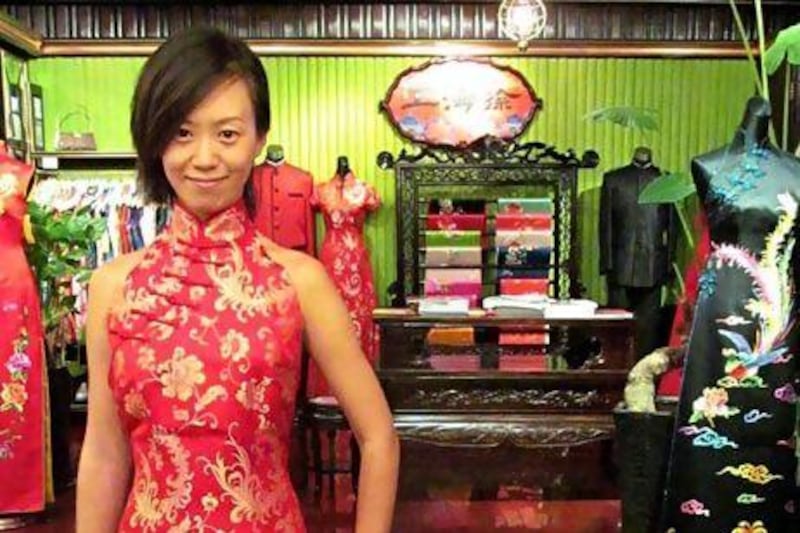BEIJING // Guo Bin tries on one dress after another as she seeks the right look for her wedding to her Italian fiance, Phillip.
A red dress with a finely woven golden pattern of leaves and flowers seems to be the favourite, the 32-year-old Ms Guo's eyes gazing approvingly at herself in the full-length mirror in front of her.
While Ms Guo, who lives in Beijing and works in the finance industry, is planning to wear a western-style white wedding dress for the ceremony, in this store in north-west Beijing she is selecting a qipao for the reception, the mix of dresses reflecting the varying cultures being brought to the union.
The qipao, a traditional one-piece Chinese dress characterised by a shape that is figure-hugging without being revealing, is typically made of silk and often features a decorative overlap on the right.
Once condemned as bourgeois, this quintessential Chinese dress has undergone a revival as women from China's middle class try to hold on to some of their country's traditions despite the breathless modernisation all around them.
"People of my parents' generation don't think wearing a qipao is fashionable, but for the younger generation it is fashionable," said Ms Guo.
"The qipao can present beauty for a Chinese person that western clothes cannot present. The elegance, the traditional beauty - only the qipao can explain it."
The design of the modern-day qipao, also known as the cheongsam, dates from Shanghai during the 1920s and 1930s, a time when the city was a melting pot of Chinese and western influences.
It combines elements of Chinese clothing with the traditional dress of the Manchus, who ran China during the Qing dynasty from 1644 to 1912, and tighter western cuts.
After disappearing during the Cultural Revolution, when the fanaticism unleashed by Mao Zedong enforced the wearing of dowdy and unflattering clothes, the dress is now commonly worn for ceremonial occasions and by female staff at top hotels and tea houses.
Weddings in China will typically see the bride wear a western-style gown for the ceremony, but a photoshoot in a qipao, as well as an appearance in one at the reception, is almost obligatory.
An intricately woven dress made from the finest silk can cost as much as 15,000 yuan (Dh8,665), although more modest examples, yet still tailor-made, may sell for about 1,600 yuan. Anyone ordering a dress will typically be faced with a choice of at least two dozen types of silk.
"There's been a clear increase in people buying qipao for special occasions. It used to be the case that people just bought western-style wear for these occasions, but now more women are buying qipaos," says Xu Qingbaio, the sales manager for the Beijing-based clothing store chain Shanghai Xu, which specialise in qipaos and which has grown from one store in 1998 to 10 now.
"I think it's just that Chinese people are getting more confident about their identity. Chinese women think the qipao is more Chinese and they like to identify themselves as Chinese women," he said.
Chen Yuan, 28, an accountant, is typical of the professional women buying qipaos. She recently had a red and green one made for her wedding reception.
"It's important, it's part of our cultural heritage. Chinese women have worn this for a very long time," she said.
The qipao's popularity has seen a Shanghai-based group for enthusiasts formed in 2007 swell to a membership of hundreds, many of whom get together for events wearing their dresses.
Recent exhibitions of qipaos in Hong Kong and Shanghai have emphasised the dress's importance as a cultural icon, while fashion houses such as Shanghai Tang and Vivienne Tam have brought the dress to a wider international audience.
Yet the qipao's position as the de facto national dress for Chinese women is subject to debate, given that in its modern form it blends western and Manchu influences as well as Chinese.
Also, it is nowhere near reclaiming the ubiquity it once enjoyed as normal day-to-day wear. It can occasionally be spotted on the streets of Beijing, but is by no means a common sight.
When Janet Cheung, a deputy chairperson of Hong Kong Fashion Designers Association, was growing up in the then British colony, the qipao was by contrast popular as an everyday garment.
"In Hong Kong, when I was a little girl, they would wear a qipao to go out shopping. It was for everyday use. At that time in China they were wearing Mao jackets," said Ms Cheung, a fashion design consultant with Cobra Creation Company.
"Women in China [today], they still prefer to wear European brands like Prada, LV and Gucci."
Ms Guo however, being keen to hold onto her country's traditions despite her forthcoming union to a non-Chinese person, remains a firm fan of the qipao.
She bought her first one nine years ago and now has several in her wardrobe, including a "more casual" qipao sometimes worn for work.
"Nowadays it's fashionable. The Chinese, they want to recapture the traditions. This is a sort of fashion for China," she said.
dbardsley@thenational.ae
Follow
The National
on
[ @TheNationalUAE ]
& Daniel Bardsley on
[ @DanielBardsley1 ]






